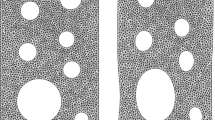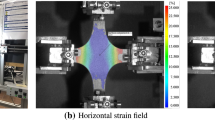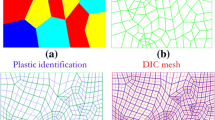Abstract
This article reviews recently developed methods for constitutive parameter identification based on kinematic full-field measurements, namely the finite element model updating method (FEMU), the constitutive equation gap method (CEGM), the virtual fields method (VFM), the equilibrium gap method (EGM) and the reciprocity gap method (RGM). Their formulation and underlying principles are presented and discussed. These identification techniques are then applied to full-field experimental data obtained on four different experiments, namely (i) a tensile test, (ii) the Brazilian test, (iii) a shear-flexural test, and (iv) a biaxial test. Test (iv) features a non-uniform damage field, and hence non-uniform equivalent elastic properties, while tests (i), (ii) and (iii) deal with the identification of uniform anisotropic elastic properties. Tests (ii), (iii) and (iv) involve non-uniform strain fields in the region of interest.














Similar content being viewed by others
References
Andrieux S, Ben Abda A, Bui HD (1997) Sur l’identification de fissures planes via le concept d’écart à la réciprocité en élasticité. C R Acad Sci Paris Ser II 324:1431–1438
Arafeh MH (1995) Identification de la loi de comportement élastique de matériaux orthotropes. Ph.D. thesis, Université de Technologie de Compiègne
Arafeh M-H, Knopf-Lenoir C, Rouger F (1995) Conception optimale d’essais de flexion de plaques orthotropes et identification. C R Acad Sci II/321:351–354
Avril S, Grédiac M, Pierron F (2004) Sensitivity of the virtual fields method to noisy data. Comput Mech 34:439–452
Avril S, Pierron F (2007) General framework for the identification of constitutive parameters from full-field measurements in linear elasticity. Int J Solids Struct 44:4978–5002
Avril S, Pierron F, Pannier Y, Rotinat R (2008) Stress reconstruction and constitutive parameter identification in plane-stress elastoplastic problems using surface measurements of deformation fields. Experimental Mechanics. doi:10.1007/s11340-007-9084-2
Ben Abda A, Ben Ameur H, Jaoua M (1999) Identification of 2D cracks by boundary elastic measurements. Inverse Problems 15:67–77
Bonnet M (1999) Boundary integral equations methods for solids and fluids. Wiley, New York
Bonnet M, Constantinescu A (2005) Inverse problems in elasticity. Inverse Probl 21:R1–R50 (topical review article)
Bui HD (1995) Sur quelques problèmes inverses élastiques en mécanique de l’endommagement. In: Deuxième colloque national de calcul des structures. Hermès, Lyon, pp 26–35
Bui HD, Constantinescu A, Maigre H (2004) Numerical identification of linear cracks in 2D elastodynamics using the instantaneous reciprocity gap. Inverse Probl 20:993–1001
Burczyński T (2003) Evolutionary computation in mechanics. IACM Expressions, Bull Int Assoc Comp Mech
Calderon AP (1980) On an inverse boundary value problem. In: Seminar on numerical analysis and its applications to continuum physics. Soc. Brasilian de Matematica, Rio de Janeiro, pp 65–73
Calloch S, Dureisseix D, Hild F (2002) Identification de modèles de comportement de matériaux solides: utilisation d’essais et de calculs. Technol Form 100:36–41
Chalal H, Avril S, Pierron F, Meraghni F (2006) Experimental identification of a damage model for composites using the grid technique coupled to the virtual fields method. Compos Part A 37:315–325
Chrysochoos A, Berthel B, Latourte F, Galtier A, Pagano S, Wattrisse B (2008) Energy analysis of HCF fatigue using DIC and IRT. The Journal of Strain Analysis for Engineering Design (in press)
Claire D, Hild F, Roux S (2004) A finite element formulation to identify damage fields. Int J Numer Methods Eng 61:189–208
Collin F, Berthaud Y, Hild F (1998) Visualisation par analyse d’images de la répartition des déformations et de l’amorçage dans un matériau composite. In: Berthaud Y, Cottron M, Dupré F, Morestin M, Moucheront P, Taroni M (eds) Photomécanique 1998. GAMAC, pp 241–248
Collins JC, Hart GC, Kennedy B (1974) Statistical identification of structures. AIAA J 12:185–190
Constantinescu A (1995) On the identification of elastic moduli from displacement-force boundary measurements. Inverse Probl Eng 1:293–315
Cottin N, Felgenhauer HP, Natke HG (1984) On the parameter identification of elastomechanical systems using input and ouput residuals. Ing-Arch 54:378–387
Cugnoni J, Gmur T, Schorderet A (2007) Inverse method based on modal analysis for characterizing the constitutive properties of thick composite plates. Comput Struct 85:1310–1320
Furgiuele FM, Muzzupappa M, Pagnotta L (1997) A full-field procedure for evaluating the elastic properties of advanced ceramics. Exp Mech 37:285–291
Genovese K, Lamberti L, Pappalettere C (2006) Mechanical characterization of hyperelastic materials with fringe projection and optimization techniques. Opt Lasers Eng 44:423–442
Geymonat G, Hild F, Pagano S (2002) Identification of elastic parameters by displacement field measurement. C R Acad Sci Paris Ser II 330:403–408
Geymonat G, Pagano S (2003) Identification of mechanical properties by displacement field measurement: a variational approach. Meccanica 38:535–545
Giraudeau A, Pierron F (2003) Simultaneous identification of stiffness and damping properties of isotropic materials from forced vibrating plates. C R Méc 331:259–264
Giton M, Caro-Bretelle AS, Ienny P (2006) Hyper-elastic behaviour identification by a forward problem resolution: application to a tear test of a silicone-rubber. Strain 42:291–297
Grédiac M (1989) Principe des travaux virtuels et identification. C R Acad Sci II/309:1–5
Grédiac M, Fournier N, Paris P-A, Surrel Y (1998) Direct identification of elastic constants of anisotropic plates by modal analysis: experiments and results. J Sound Vib 210:645–659
Grédiac M, Pierron F (1998) A T-shaped specimen for the direct characterization of orthotropic materials. Int J Numer Methods Eng 41:293–309
Grédiac M, Pierron F (2006) Applying the virtual fields method to the identification of elasto-plastic constitutive parameters. Int J Plast 22:602–627
Grédiac M, Pierron F, Surrel Y (1999) Novel procedure for complete in-plane composite characterization using a T-shaped specimen. Exp Mech 39:142–149
Grédiac M, Toussaint E, Pierron F (2002) Special virtual fields for the direct determination of material parameters with the virtual fields method. 2-application to in-plane properties. Int J Solids Struct 39:2707–2730
Grédiac M, Toussaint E, Pierron F (2003) Special virtual fields for the direct determination of material parameters with the virtual fields method. 3-application to the bending rigidities of anisotropic plates. Int J Solids Struct 40:2401–2419
Grédiac M, Vautrin A (1990) A new method for determination of bending rigidities of thin anisotropic plates. J Appl Mech 57:964–968
Grédiac M, Vautrin A (1993) Mechanical characterization of anisotropic plates: experiments and results. Eur J Mech A Solids 12:819–838
Hadj-Sassi K, Andrieux S (2007) Une nouvelle fonctionnelle d’énergie incrémentale totale pour le contrle des parties réversibles et dissipatives des matériaux standards. In: Actes du Huitième Colloque National en Calcul des Structures. Hermes, Lyon, pp 255–261
Hemez FM, Farhat C (1993) Updating finite element dynamic models using element-by-element sensitivity methodology. AIAA J 32:1702–1711
Hild F (1992) Dispositif de traction-compression d’une éprouvette. E.N.S. Cachan/Renault, French patent nr. 90 06848 (Bulletin Officiel de la propriété industrielle, 92/33, publication nbr. 2 662 801)
Hild F (2002) CORRELILMT: a software for displacement field measurements by digital image correlation. LMT-Cachan, internal report 254
Hild F, Amar E, Marquis D (1992) Stress heterogeneity effect on the strength of silicon nitride. J Am Ceram Soc 75:700–702
Hild F, Périé J-N, Coret M (1999) Mesure de champs de déplacements 2D par intercorrélation d’images : CORRELILMT. LMT-Cachan, internal report 230
Hild F, Raka B, Baudequin M, Roux S, Cantelaube F (2002) Multi-scale displacement field measurements of compressed mineral wool samples by digital image correlation. Appl Opt Inf Process 41:6815–6828
Hild F, Roux S (2006) Digital image correlation: from measurement to identification of elastic properties—a review. Strain 42:69–80
Hoc T, Gélébart L, Crépin J, Zaoui A (2003) A procedure for identifying the plastic behaviour of single crystals from the local response of polycrystals. Acta Mater 51:5479–5490
Ikehata M (1990) Inversion formulas for the linearized problem for an inverse boundary value problem in elastic prospection. SIAM J Appl Math 50:1635–1644
Ikehata M (1993) An inverse problem for the plate in the Love-Kirchhoff Theory. SIAM J Appl Math 53:942–970
Iosipescu N (1967) New accurate procedure for single shear testing of metals. J Mater 2:537–566
Kajberg J, Lindkvist G (2004) Characterization of materials subjected to large strains by inverse modelling based on in-plane displacement fields. Int J Solids Struct 41:3439–3459
Kajberg J, Sundin KG, Melin LG, Ståhle P (2004) High strain rate tensile and viscoplastic parameter identification using micoscopic high-speed photography. Int J Plast 20:561–575
Kavanagh KT, Clough RW (1971) Finite element applications in the characterization of elastic solids. Int J Solids Struct 7:11–23
Ladevèze P, Nedjar B, Reynier M (1994) Updating of finite element models using vibration tests. AIAA 32:1485–1491
Ladevèze P, Reynier M (1989) A localization method of stiffness errors for the adjustement of F.E. models. In: Proceedings F.E. modeling and analysis in vibrations analysis techniques and applications. ASME, New York, pp 355–361
Latourte F, Chrysochoos A, Pagano S, Wattrisse B (2008) Elastoplastic behavior identification for heterogeneous loadings and materials. Exp Mech (in press)
Lecompte D, Sol H, Vantomme J, Habraken AM (2005) Identification of elastic orthotropic material parameters based on ESPI measurements. In: SEM annual conference and exposition on experimental and applied mechanics, Portland, 7–9 June 2005
Lecompte D, Sol H, Vantomme J, Habraken AM (2007) Mixed numerical-experimental technique for orthotropic parameter identification using biaxial tensile tests on cruciform specimens. Int J Solids Struct 44:1643–1656
Lemaître J, Chaboche JL (1990) Mechanics of solid materials. Cambridge University Press, Cambridge
Lobo Carneiro FC (1943) Um novo método para determinacão da resistência à tração dos concretos. In: Proceedings Anais 5a Reunião da Associação Brasileira de Normas Técnicas (ABNT) em São Paulo, pp 127–129
Lobo Carneiro FC (1953) Une nouvelle méthode pour la détermination de la résistance à la traction des bétons. Bull RILEM 13:103–108
Magorou LL, Bos F, Rouger F (2002) Identification of constitutive laws for wood-based panels by means of an inverse method. Compos Sci Technol 62:591–596
Mahnken R (2004) A comprehensive study of a multiplicative elastoplasticity model coupled to damage to include parameter identification. Comput Struct 74:179–200
Mauvoisin G, Bremand FJ, Lagarde A (1994) Three-dimensional shape reconstruction by phase-shifting shadow moire. Appl Opt 33:2163–2169
Meijer R, Douven LFA, Oomens CWJ (1997) Characterisation of anisotropic and non-linear behaviour of human skin in-vivo. Comput Methods Biomech Biomed Eng 1:13–27
Meuwissen M (1998) An inverse method for the mechanical characterization of metals. Ph.D. thesis, Eindhoven University of Technology
Meuwissen MHH, Oomens CWJ, Baaijens FPT, Petterson R, Janssen JD (1998) Determination of the elasto-plastic properties of aluminium using a mixed numerical-experimental method. J Mater Process Technol 75:204–211
Moës N, Ladevèze P, Douchin B (1999) Constitutive relation error estimators for (visco) plastic finite element analysis with softening. Comput Methods Appl Mech Eng 176:247–264
Molimard J, Le Riche R, Vautrin A, Lee JR (2005) Identification of the four orthotropic plate stiffnesses using a single open-hole tensile test. Exp Mech 45:404–411
Moreau A, Pagnacco E, Borza D, Lemosse D (2006) An evaluation of different mixed experimental/numerical procedures using FRF for the identification of viscoelastic materials. In: International conference on noise and vibration engineering, ISMA 2006, Leuven, 18–20 September 2006
Nguyen HM, Allix O, Feissel P (2006) Application of the CRE for parameter identification in nonlinear dynamics with corrupted measurements. Seventh World Congress on Computational Mechanics, Los Angeles, July 2006
Oomens CWJ, van Ratingen MR, Janssen JD, Kok JJ, Hendriks MAN (1993) A numerical-experimental method for a mechanical characterization of biological materials. J Biomech 26:617–621
Padmanabhan S, Hubner JP, Kumar AV, Ifju PG (2006) Load and boundary condition calibration using full-field measurement. Exp Mech 46:569–578
Pagnacco E, Lemosse D (2006) A coupled FE based inverse strategy from displacement field measurement subject to an unknown distribution of forces. In: Photomechanics 2006, Clermont-Ferrand, 10–12 July 2006
Pagnacco E, Lemosse D, Hild F, Amiot F (2005) Inverse strategy from displacement field measurement and distributed forces using FEA. In: 2005 SEM annual conference and exposition on experimental and applied mechanics, Portland, 7–9 June 2005
Pagnacco E, Moreau A, Lemosse D (2007) Inverse strategies for the identification of elastic and viscoelastic material paremeters using full-field measurements. Mater Sci Eng A 452–453:737–745
Perié JN, Calloch S, Cluzel C, Hild F (2002) Analysis of a multiaxial test on a C/C composite by using digital image correlation and a damage model. Exp Mech 42: 318–328
Pierron F, Grédiac M (2000) Identification of the through-thickness moduli of thick composites from whole-field measurements using the Iosipescu fixture: theory and simulations. Compos Part A 31:309–318
Rastogi PK (1999) Photomechanics. Springer, Berlin
Renaud P (2000) Comportement d’un matériau composite carbone/carbone 3D sous chargement uniaxial. Master’s thesis, ENS Cachan
Surrel Y (2004) Les techniques optiques de mesure de champ: essai de classification. Instrum Mes Metro 4:11–42
Tarantola A (1987) Inverse problem theory. Elsevier, Amsterdam
Thomas JW (1999) Numerical partial differential equations: conservation laws and elliptic equations. Springer, Berlin
Toussaint E, Grédiac M, Pierron F (2006) The virtual fields method with piecewise virtual fields. Int J Mech Sci 48:256–264
van Ratingen MR (1994) Mechanical identification of inhomogeneous solids: a mixed numerical experimental approach. Ph.D. thesis, Eindhoven University of Technology
Author information
Authors and Affiliations
Corresponding author
Additional information
Working group “Identification” of the French CNRS research network (GDR 2519) “Mesures de champs et identification en Mécanique des Solides / Full-field Measurements and Identification in Solid Mechanics”.
Rights and permissions
About this article
Cite this article
Avril, S., Bonnet, M., Bretelle, AS. et al. Overview of Identification Methods of Mechanical Parameters Based on Full-field Measurements. Exp Mech 48, 381–402 (2008). https://doi.org/10.1007/s11340-008-9148-y
Received:
Accepted:
Published:
Issue Date:
DOI: https://doi.org/10.1007/s11340-008-9148-y




